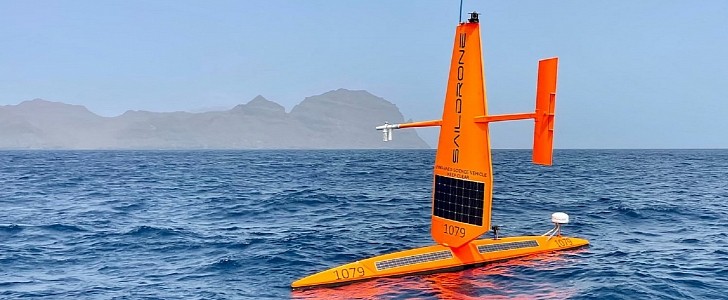Last year, California-based USV (uncrewed surface vehicle) manufacturer Saildrone made the global headlines when one of its ocean drones captured a video inside category four Hurricane Sam in the Atlantic Ocean. Those same vehicles are now getting ready for another busy season of collecting critical data.
Back in October, a Saildrone Explorer SD 1045 captured valuable footage inside Hurricane Sam, withstanding massive waves (50 ft/115.2 m) and strong winds of over 100 mph (161 kph). The brave drone remained intact and managed to send the first-ever live video footage from inside the eye of the storm. The collected data is very valuable for scientists who can use it to improve forecast models.
Saildrone is now once again deploying its ocean drones, both in the Atlantic Ocean and, for the first time, in the Gulf of Mexico to gather more vital information. The USV manufacturer says that seven of its sailing drones were recently deployed with the support of NOAA’s Global Ocean Monitoring and Observing Program. Two of them sailed into the Gulf while the rest of them were deployed into the Tropical Atlantic.
With the National Oceanic and Atmospheric Administration (NOAA) predicting another challenging hurricane season this year, with up to 21 named storms and up to six major hurricanes, Saildrone’s USVs are valuable tools that can monitor the conditions that play a role in hurricane intensity changes, as explained by John Cortinas, Director of NOAA’s Atlantic Oceanographic and Meteorological Laboratory (AOML). Cortinas added that these types of real-time observing systems are crucial to better understand the processes that lead to the formation and intensification of hurricanes, helping to reduce their damage.
Saildrone’s oceanic drones come in three models: Explorer, Voyager, and Surveyor, with the former being the smallest, measuring 23 ft (7 m) in length and the Surveyor, the largest, at 72 ft (22 m) long. The Explorer drones are wind and solar-powered vehicles designed to cope with the harshest conditions.
Seven of these Explorers will each operate in a pre-selected area and will transmit in situ meteorological and oceanographic data in real-time, such as air temperature, relative humidity, barometric pressure, wind speed, wind direction, sea surface temperature, wave height, and more. The drones will help NOAA understand hurricane intensification, with the collected data to be provided directly to NOAA’s AOML and the Pacific Marine Environmental Laboratory.
Saildrone is now once again deploying its ocean drones, both in the Atlantic Ocean and, for the first time, in the Gulf of Mexico to gather more vital information. The USV manufacturer says that seven of its sailing drones were recently deployed with the support of NOAA’s Global Ocean Monitoring and Observing Program. Two of them sailed into the Gulf while the rest of them were deployed into the Tropical Atlantic.
With the National Oceanic and Atmospheric Administration (NOAA) predicting another challenging hurricane season this year, with up to 21 named storms and up to six major hurricanes, Saildrone’s USVs are valuable tools that can monitor the conditions that play a role in hurricane intensity changes, as explained by John Cortinas, Director of NOAA’s Atlantic Oceanographic and Meteorological Laboratory (AOML). Cortinas added that these types of real-time observing systems are crucial to better understand the processes that lead to the formation and intensification of hurricanes, helping to reduce their damage.
Saildrone’s oceanic drones come in three models: Explorer, Voyager, and Surveyor, with the former being the smallest, measuring 23 ft (7 m) in length and the Surveyor, the largest, at 72 ft (22 m) long. The Explorer drones are wind and solar-powered vehicles designed to cope with the harshest conditions.
Seven of these Explorers will each operate in a pre-selected area and will transmit in situ meteorological and oceanographic data in real-time, such as air temperature, relative humidity, barometric pressure, wind speed, wind direction, sea surface temperature, wave height, and more. The drones will help NOAA understand hurricane intensification, with the collected data to be provided directly to NOAA’s AOML and the Pacific Marine Environmental Laboratory.







